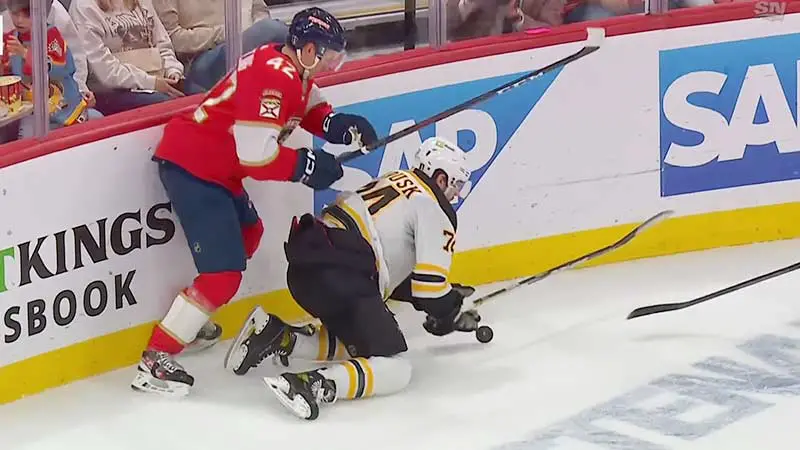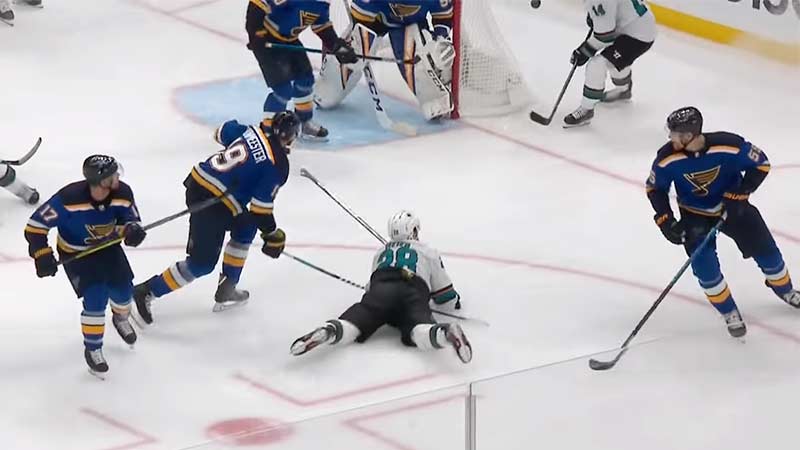Hand pass rules in NHL hockey are a frequent source of debate, as exemplified by the controversial overtime decision during the 2019 Stanley Cup playoffs between San Jose and St. Louis.
Understanding these regulations is crucial for players and fans to uphold fairness and sportsmanship in the sport.
The guidelines state that players cannot hold onto the puck or advance with it after making a hand pass, emphasizing the importance of fair play and competitive balance in NHL games.
This clarity helps ensure that the game is played fairly and consistently by all teams involved, ultimately maintaining the integrity of the sport and upholding standards of sportsmanship among players and fans alike.
Understanding the NHL Hand Pass Rule
The Basics of the Rule
In NHL hockey, the hand pass rule prohibits players from using their hands to pass the puck to a teammate.
Players must use their sticks to move the puck around the ice to ensure fair play and maintain the integrity of the game. This rule aims to prevent unfair advantages or disruptions in gameplay that could affect the outcome of a match.
Situations and Penalties
When a player violates the hand pass rule, various situations and penalties may occur. If a player commits a hand pass in the defensive zone, where it’s considered legal to do so, play will continue without penalties.
However, if a player makes a hand pass in the offensive zone or any other area on the ice, the referees will stop play and assess a penalty.
Consequences for breaking the hand pass rule can range from minor penalties to potentially more severe disciplinary actions depending on the severity and intention behind the violation.
The Impact of the Hand Pass Rule on the Game

Game Flow and Player Strategy
The hand pass rule in NHL hockey significantly influences the flow of the game and player strategy.
Players must rely on their stick-handling skills and teamwork to advance the puck, enhancing the overall speed and competitiveness of the gameplay.
By restricting the use of hands to pass the puck, the rule encourages precision and skillful play. Teams need to focus on strategic positioning and quick passes to outmaneuver their opponents effectively.
Understanding and adhering to this rule are essential for players to navigate the game successfully and maintain a fair and engaging competition on the ice.
Controversial Calls and Game Outcomes
Controversial calls related to hand passes can have a profound impact on game outcomes. Instances where officials must determine whether a hand pass was intentional or accidental can lead to heated debates and alter the course of a match.
The enforcement of the hand pass rule can result in penalties that affect power play opportunities, scoring chances, and overall team performance.
Teams involved in contentious hand pass situations may face game-changing decisions that can sway the momentum of the game. Therefore, clarity and consistency in applying the hand pass rule are crucial to ensuring fair play and determining the final result in NHL matches.
Comparing the NHL Rule to Other Leagues
Similarities with International Hockey Rules
When comparing the NHL hand pass rule to international hockey regulations, similarities in enforcing fair play become evident. Just like in the NHL, international hockey rules strictly prohibit hand passes to maintain the integrity of the game.
This similarity ensures consistent gameplay standards across different hockey leagues, emphasizing skillful play and strategic teamwork.
Understanding and adhering to the hand pass rule is essential in international hockey, mirroring the importance placed on fair play in the NHL.
Differences from Amateur Hockey Regulations
In contrast to amateur hockey regulations, the NHL hand pass rule has distinct differences that impact gameplay dynamics.
Unlike in some amateur leagues where hand passes may be allowed under certain circumstances, the NHL maintains a strict prohibition on hand passes to uphold the highest standards of competition and sportsmanship.
These differences highlight the unique characteristics of NHL gameplay, emphasizing precision, skill, and adherence to rule enforcement.
Understanding these disparities is crucial for players, coaches, and fans to grasp the nuances of NHL gameplay and appreciate the league’s commitment to fair and consistent game outcomes.
Calls for Change in the Hand Pass Rule

Criticism and Controversy
Critics of the current NHL hand pass rule have voiced concerns about its ambiguity and the potential for missed or incorrect calls by officials.
The lack of clarity in defining what constitutes a hand pass often leads to heated debates among players, coaches, and fans.
Controversial decisions based on subjective interpretations of the rule have sparked frustration and discontent within the hockey community.
Proposals for Rule Modifications
In response to the criticism and controversy surrounding the hand pass rule, various proposals for rule modifications have been suggested to enhance clarity and consistency in officiating.
One common suggestion is to introduce stricter guidelines on hand passes, clearly outlining the permissible actions and penalizing infractions more consistently.
Additionally, there have been calls to implement technology, such as video review, to aid officials in making accurate calls regarding hand passes.
These proposals aim to address the concerns raised by critics and improve the overall fairness and transparency of the hand pass rule in NHL hockey.
Frequently Asked Questions
What is a hand pass in NHL hockey?
A hand pass in NHL hockey occurs when a player uses their hand to pass the puck to a teammate, which is not allowed except within their defending zone.
Why is the hand pass rule important in NHL hockey?
The hand pass rule is crucial in maintaining fairness and preventing unfair advantages in the game by prohibiting players from using their hands to pass the puck.
What are the concerns surrounding the current NHL hand pass rule?
Critics have raised concerns about the ambiguity of the rule, leading to potential missed or incorrect calls by officials and sparking debates within the hockey community.
Are there any proposed modifications to the hand pass rule?
Various proposals have been suggested to address the issues with the hand pass rule, including stricter guidelines on hand passes and the use of technology like video review for better officiating consistency.
How do proposed rule modifications aim to improve NHL hockey?
The proposed rule modifications aim to enhance clarity, fairness, and transparency in enforcing the hand pass rule, ultimately improving the overall game experience in NHL hockey.
Conclusion
Understanding and adhering to the NHL hand pass rule is crucial for maintaining fairness and sportsmanship in hockey.
The criticisms and controversies surrounding the current rule highlight the need for clarity and consistency in officiating.
Proposed modifications, such as stricter guidelines and the use of technology for review, aim to address these concerns.
By enhancing transparency and enforcing the rule effectively, the NHL can ensure a level playing field for all teams. Keeping the spirit of fair competition alive, the league continues to evolve its rules to meet the demands of the game and uphold its integrity.








James Felix